Xenofon Vasilakos
Cooperative Task Offloading through Asynchronous Deep Reinforcement Learning in Mobile Edge Computing for Future Networks
Apr 24, 2025Abstract:Future networks (including 6G) are poised to accelerate the realisation of Internet of Everything. However, it will result in a high demand for computing resources to support new services. Mobile Edge Computing (MEC) is a promising solution, enabling to offload computation-intensive tasks to nearby edge servers from the end-user devices, thereby reducing latency and energy consumption. However, relying solely on a single MEC server for task offloading can lead to uneven resource utilisation and suboptimal performance in complex scenarios. Additionally, traditional task offloading strategies specialise in centralised policy decisions, which unavoidably entail extreme transmission latency and reach computational bottleneck. To fill the gaps, we propose a latency and energy efficient Cooperative Task Offloading framework with Transformer-driven Prediction (CTO-TP), leveraging asynchronous multi-agent deep reinforcement learning to address these challenges. This approach fosters edge-edge cooperation and decreases the synchronous waiting time by performing asynchronous training, optimising task offloading, and resource allocation across distributed networks. The performance evaluation demonstrates that the proposed CTO-TP algorithm reduces up to 80% overall system latency and 87% energy consumption compared to the baseline schemes.
iOn-Profiler: intelligent Online multi-objective VNF Profiling with Reinforcement Learning
Dec 14, 2023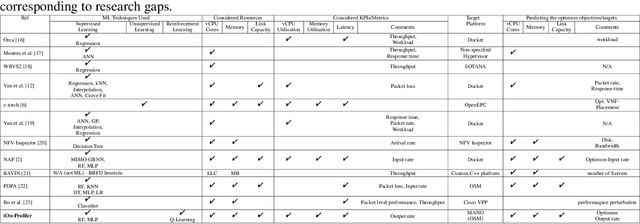
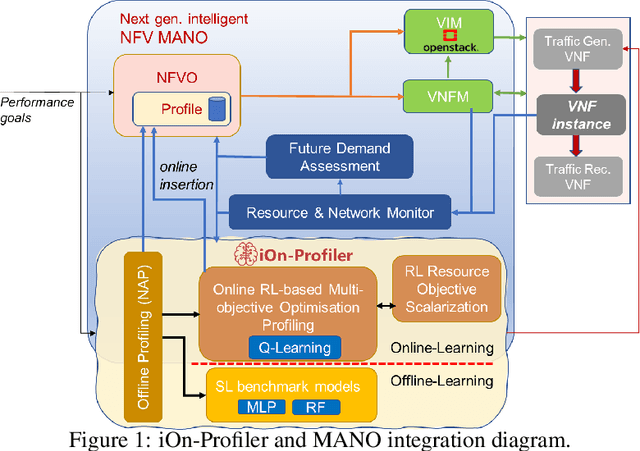
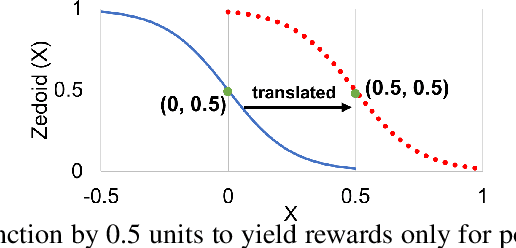
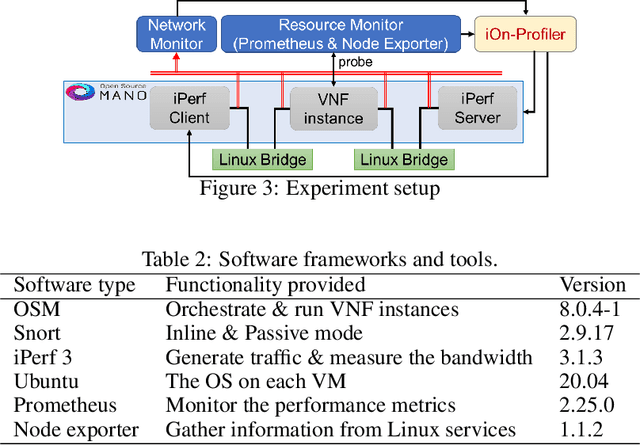
Abstract:Leveraging the potential of Virtualised Network Functions (VNFs) requires a clear understanding of the link between resource consumption and performance. The current state of the art tries to do that by utilising Machine Learning (ML) and specifically Supervised Learning (SL) models for given network environments and VNF types assuming single-objective optimisation targets. Taking a different approach poses a novel VNF profiler optimising multi-resource type allocation and performance objectives using adapted Reinforcement Learning (RL). Our approach can meet Key Performance Indicator (KPI) targets while minimising multi-resource type consumption and optimising the VNF output rate compared to existing single-objective solutions. Our experimental evaluation with three real-world VNF types over a total of 39 study scenarios (13 per VNF), for three resource types (virtual CPU, memory, and network link capacity), verifies the accuracy of resource allocation predictions and corresponding successful profiling decisions via a benchmark comparison between our RL model and SL models. We also conduct a complementary exhaustive search-space study revealing that different resources impact performance in varying ways per VNF type, implying the necessity of multi-objective optimisation, individualised examination per VNF type, and adaptable online profile learning, such as with the autonomous online learning approach of iOn-Profiler.
Integrated Methodology to Cognitive Network Slice Management in Virtualized 5G Networks
May 11, 2020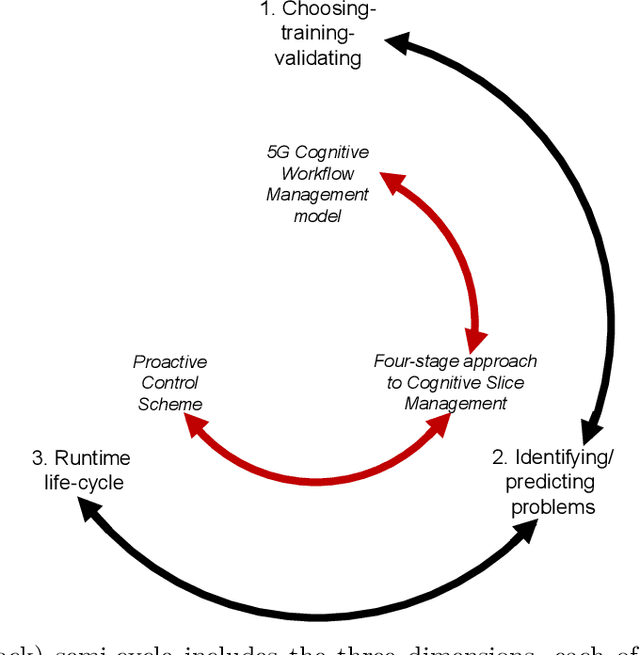
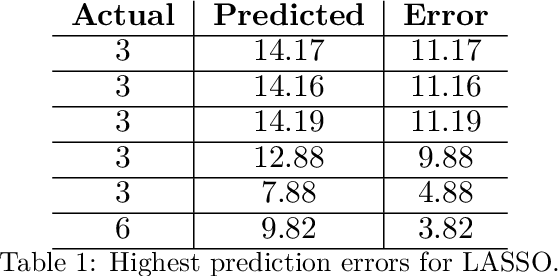
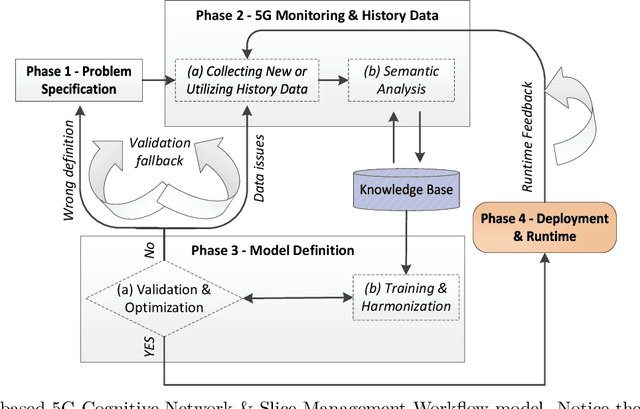
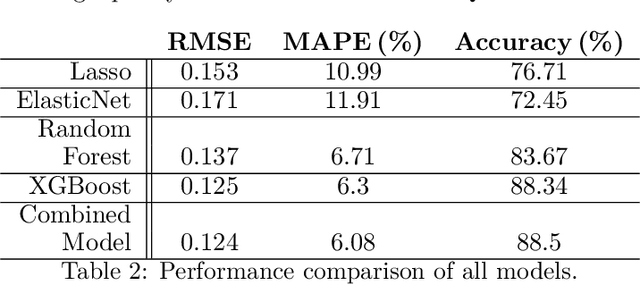
Abstract:Fifth Generation (5G) networks are envisioned to be fully autonomous in accordance to the ETSI-defined Zero touch network and Service Management (ZSM) concept. To this end, purpose-specific Machine Learning (ML) models can be used to manage and control physical as well as virtual network resources in a way that is fully compliant to slice Service Level Agreements (SLAs), while also boosting the revenue of the underlying physical network operator(s). This is because specially designed and trained ML models can be both proactive and very effective against slice management issues that can induce significant SLA penalties or runtime costs. However, reaching that point is very challenging. 5G networks will be highly dynamic and complex, offering a large scale of heterogeneous, sophisticated and resource-demanding 5G services as network slices. This raises a need for a well-defined, generic and step-wise roadmap to designing, building and deploying efficient ML models as collaborative components of what can be defined as Cognitive Network and Slice Management (CNSM) 5G systems. To address this need, we take a use case-driven approach to design and present a novel Integrated Methodology for CNSM in virtualized 5G networks based on a concrete eHealth use case, and elaborate on it to derive a generic approach for 5G slice management use cases. The three fundamental components that comprise our proposed methodology include (i) a 5G Cognitive Workflow model that conditions everything from the design up to the final deployment of ML models; (ii) a Four-stage approach to Cognitive Slice Management with an emphasis on anomaly detection; and (iii) a Proactive Control Scheme for the collaboration of different ML models targeting different slice life-cycle management problems.
 Add to Chrome
Add to Chrome Add to Firefox
Add to Firefox Add to Edge
Add to Edge